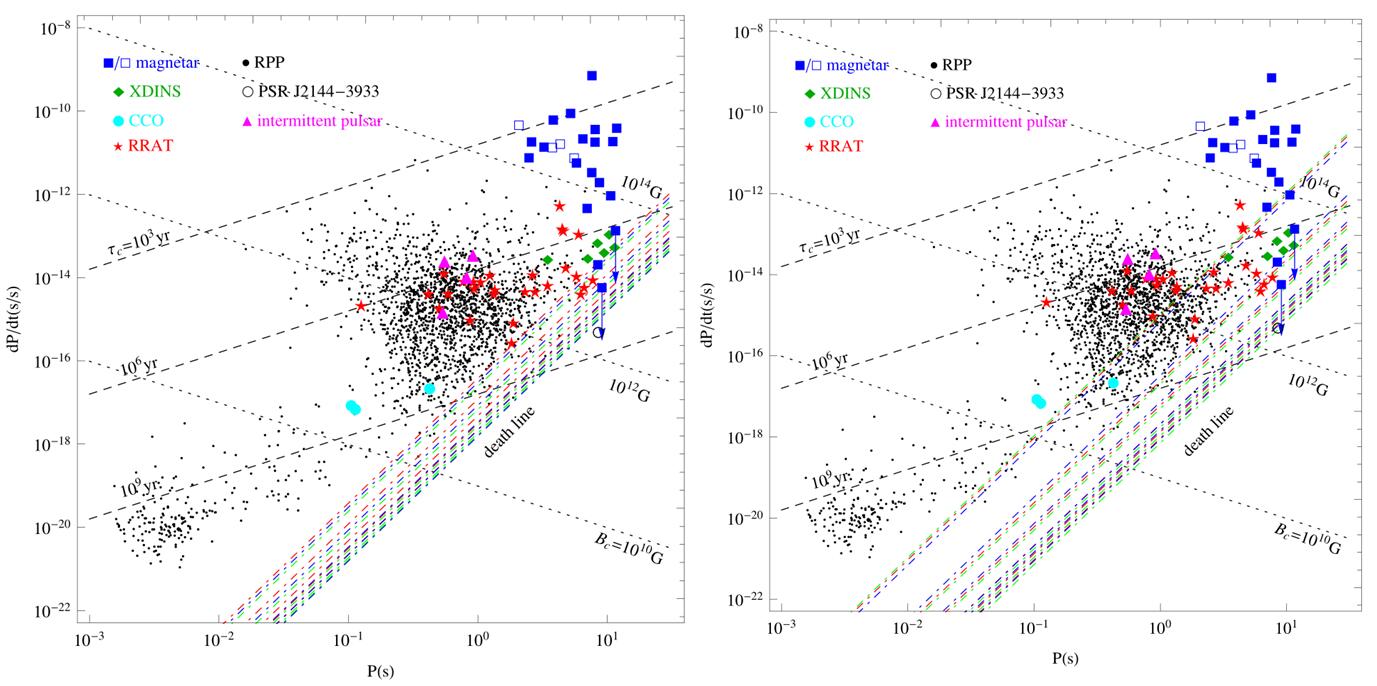A useful starting point for understanding the diverse flavors of pulsars is to place them on the  plane, where the spin period, P, and the period derivative,
plane, where the spin period, P, and the period derivative,  , of a pulsar can be obtained at very high levels of precision through timing measurements. Pulsar death line can be defined in a
, of a pulsar can be obtained at very high levels of precision through timing measurements. Pulsar death line can be defined in a  diagram. Traditionally, radio-loud pulsars are supposed to locate above the death line where there is a radio-loud region. However, the studies of new classes of neutron stars, such as magnetars, X-ray dim isolated neutron stars (XDINS), central compact objects (CCOs) and rotating radio transients (RRATs), show that some groups, such as XDINSs, CCOs and some magnetar, lie above the death line but they are radio-quiet. Besides the beaming effect and ultra-low radio luminosities, it seems that going back to the basic concept of pulsar death line could help us to understand these phenomena from another perspective. From the definition of the pulsar death line, different equations of state (EoSs) for a neutron star or a strange star result in different death lines.
diagram. Traditionally, radio-loud pulsars are supposed to locate above the death line where there is a radio-loud region. However, the studies of new classes of neutron stars, such as magnetars, X-ray dim isolated neutron stars (XDINS), central compact objects (CCOs) and rotating radio transients (RRATs), show that some groups, such as XDINSs, CCOs and some magnetar, lie above the death line but they are radio-quiet. Besides the beaming effect and ultra-low radio luminosities, it seems that going back to the basic concept of pulsar death line could help us to understand these phenomena from another perspective. From the definition of the pulsar death line, different equations of state (EoSs) for a neutron star or a strange star result in different death lines.
The properties of death lines are affected by EoSs without considering the magnetosphere and particle acceleration model. Observational constraints on EoSs are also considered. The results show that central compact objects would be the small mass of self-bound strange stars, and rotating radio transients might be old pulsars on the verge of death. We suggest that PSR J2144−3933 is likely to be a large mass pulsar, which would be larger than two solar mass. Multiple observational facts would help us to reveal the nature of pulsars.
The dense matter EoS is the main scientific objective for a number of different telescopes over the next decade, operating in very different wavebands, such as the Square Kilometre Array (SKA), the Five hundred meter Aperture Spherical radio Telescope (FAST), Neutron Star Interior Composition Explorer Mission (NICER), Enhanced X-ray Timing and Polarization mission (eXTP), etc.

Left diagram: The period of different neutron star groups
Right diagram: The period of different strange stars
Article Link: https://academic.oup.com/mnras/article/472/2/2403/4083633
The Authors: Xia, Zhou.; Hao, Tong.; Cui, Zhu.; Na, Wang.;